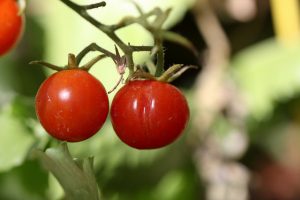
Good day. Last year I wanted to create a solid supply of tomatoes for the winter, but in the end I almost remained without a crop at all.
And the blame was the whitefly, which felt at home in my greenhouse.
It is good that at that time my grandfather came to visit me, who has considerable experience in the fight against all kinds of pests. Whitefly was successfully "evicted." Want to learn how to get rid of whiteflies on tomatoes in a greenhouse? How to prevent its reappearance. In the article below, I will discuss these and other issues in detail.
The content of the article:
- 1 How to get rid of whiteflies on tomatoes
- 2 Effective methods for controlling whitefly on tomatoes in a greenhouse
- 3 Whitefly on Tomatoes in a Greenhouse: 7 Tips for Combating and Preventing
- 4 How to get rid of pests on tomatoes in a greenhouse
- 5 How to deal with whitefly on tomatoes
- 6 How to get rid of whiteflies
- 7 The appearance of whiteflies on tomatoes in a greenhouse: 3 methods of control
How to get rid of whiteflies on tomatoes
Whitefly is a small white moth. The size of this pest is from 1 to 2 mm. The wings are covered with a plaque reminiscent of powder. An adult can lay up to 250 eggs on tomato leaves. The larvae of these insects attach to the back of the tomato leaf and suck out the juice from it. As a result, the leaves dry and fall.
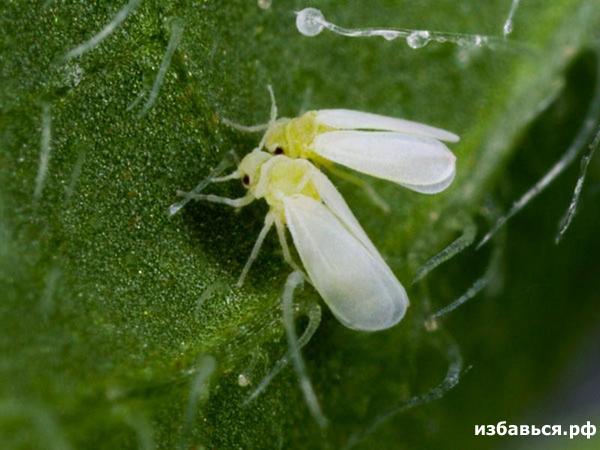
There are several types of this pest. The greenhouse whitefly is found mainly in warm places on our planet. It affects tomatoes, cucumbers, as well as some flowers.
If you find a pest on tomato bushes, you must immediately begin to fight it. Otherwise, the insect, having destroyed the tomatoes, will move to the bushes of other vegetables and berries.
Methods of struggle
The fight against this pest must begin already in the greenhouse, where tomato bushes grow. For starters, you can use special traps lubricated with adhesive. Today they can be freely found in the market or in a specialized store. You can make such a trap yourself.
Time and experience suggest that whiteflies can be removed with the emulsion used in scabies. This product can be purchased at the pharmacy. We breed about 50 grams of the drug in one liter of water and spray the problematic plant bushes.
Yarrow solution. Grind 80g of yarrow, pour one liter of hot water and leave in a dark place for a day. Then the filtered solution can be processed plants. Large leaves are best wiped with a cloth soaked in this liquid.
The concentrated solution of laundry soap.To do this, grate the soap and pour warm water in proportion (1: 6).
Infusion of garlic. Grind 10 g of garlic and add two liters of water. Insist for 24 hours, then strain. Fresh infusion to spray tomatoes after sunset.
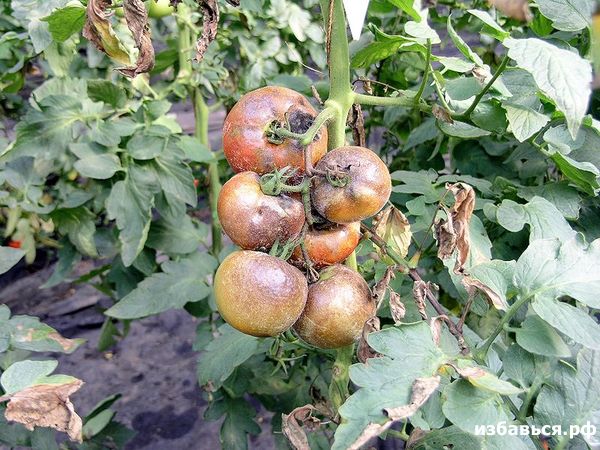
Bushes of tomatoes are treated with a stream of clean water. Small moths can easily be flushed with water from a hose. After that, it is necessary to loosen the soil under the bushes ..
If you find a whitefly on tomatoes too late, you will have to take drastic pest control measures. In this case, you need to resort to the use of chemicals. In addition, a poisonous agent will have to process not only tomato bushes, but also nearby plants to prevent them from becoming infected with this pest.
Today, you can find in stores a wide variety of chemical agents to control whitefly. These are drugs such as Actellik, Confidor, Pegasus, Verticillin, Fufanon, etc. In the instructions attached to each of these drugs, you can learn about how to use the poison.
Preventive actions
The fight against whiteflies, as well as with any plant pest, can last the whole season. The use of chemicals adversely affects plants, people, and domestic animals. Therefore, avid gardeners know that it is better to prevent the appearance of harmful insects. Whitefly is a fragile moth.
Before planting tomatoes, it is advisable to paint with fresh paint all parts of the greenhouse design. Remove the land from last year's tops and grass, and then dig it carefully.
For winter, do not leave compost in the garden, as this will be a great place where whiteflies can winter. During frosts, you can open the greenhouse so that it freezes.
If you buy ready-made seedlings of tomatoes, be sure to conduct a thorough check of plants so that they are not infected by pests.
Effective methods for controlling whitefly on tomatoes in a greenhouse
The tiny, moth-like insect, the size of which does not exceed 3 mm, belongs to the aleurodide family.
In total, there are more than a thousand species of whiteflies, but we are interested in the greenhouse or greenhouse, which lives on tomatoes, as well as cucumbers, eggplants and even flowers.
The insect is characterized by intensive reproduction, and therefore, if the larvae of this “beast” were noticed on the leaves of plants or the adult butterflies themselves, they must be destroyed immediately.
How to identify a parasite?
- Tomatoes begin to curl leaves, then they turn yellow and dry.
- On the underside of the leaf, colonies of whitefly larvae that feed on the juice of the stem and leaves can be seen.
- The appearance of sticky plaque on tomato leaves.
- The appearance of necrotic spots.
- When you touch the plants, numerous small insects with whitish wings can fly.
Whitefly is a dangerous pest. Larvae suck juices from plants, which leads to the drying out and death of tomatoes. Adult whiteflies feed on leaves, and since the number of voracious insects is usually large, a tomato bush can be destroyed in a few days.
Whitefly is a carrier of various viruses, so it can be a source of infection of plants in shelters.
Where does the whitefly come from in the greenhouse? Sources are contaminated soil, seedlings, which were purchased on the market or in the greenhouse, untreated on time and rotting plant debris.
The pest appears in greenhouses, where they do not observe the ventilation mode, as well as where tomato plants are planted too closely.
The insect goes through three stages in its development. The fight against whiteflies in a tomato greenhouse is complicated by the fact that on one tomato plant there can be individuals of all stages of development, therefore, the application of different control methods at the same time gives the best result.
Mechanical methods
You can get rid of whiteflies in such ways.
Rubbing tomato leaves with a cloth dampened in soapy water. Laundry soap is often used to prepare various compositions that help in the difficult work of a gardener. It will come to the rescue in this case too. Proportion: 1 part soap to 6 parts water.
Then it is necessary to apply honey, petroleum jelly or castor oil to their surface and attach traps in the greenhouse near the plants. Today, in specialized stores, ready-made traps are also sold that use special non-drying glue.
Biological methods
In this case, insects are attracted to help, which are the natural enemies of whiteflies, but are safe for humans and tomatoes.
These include:
- ladybugs;
- lacewings;
- predatory bug macrolofus;
- Enkarsia pupae (parasitoid wasp).
If insects are used for control, then chemical preparations cannot be used simultaneously with them.
Folk remedies in the fight against pest
- The infusion of garlic is used to spray tomatoes. Processing is carried out once every few days, trying to ensure that the solution gets on the larvae and adults. Preparation: liter of water, 150 grams of chopped garlic cloves. All insist for 5-6 days.
- Yarrow infusion also helps get rid of whiteflies. It is necessary to take 100 grams of crushed plants per liter of hot water, insist 24 hours and then spray.
- In the same way, gardeners use dandelion infusion. Composition: about 80-100 grams of dandelion roots are taken per 1 liter of boiling water. Insist a day, used for spraying.
The compositions prepared according to these recipes are effective in cases where there are not so many pests in the greenhouse. If the situation has gone too far, you will have to use chemicals.
Chemical methods of control
The stores have a huge selection of different drugs, so gardeners can always buy them to deal with the pest. Some use traditional dichlorvos, but it is better to choose specialized remedies.
Among the most effective:
- Verticillin - dilute 25 ml per liter of water. Sprayed twice, interval - 10 days.
- Pegasus is a well-proven drug used for spraying. Diluted in a ratio of 2 ml of the composition per 1 liter of water, spraying is carried out twice, withstanding a break of 7-10 days.
- Confidor. Usually spend only one spray.
- Actellik. On sale, the drug is presented in ampoules, for the processing of tomatoes, one ampoule per liter of water is enough. They process it two to three times, the result is noticeable already on the second or third day after spraying.
The use of chemical compounds is carried out strictly according to the instructions and only in the indicated doses and proportions.Therefore, make it a rule: before processing plants, carefully read the instructions for the drug!
Preventative measures
So that the whitefly does not appear in the greenhouse, it is imperative to follow the rules of tomato farming, and also do not forget about prevention.
- You need to buy tomato seedlings only from trusted and reliable sellers.
- Every year in the fall, after harvesting, the greenhouse should be disinfected. To do this, use a solution of copper sulfate, potassium permanganate. Digging the land, cleaning all plant debris, grass is also required.
- Freezing soil in a greenhouse. Conducted with the onset of cold weather, so that the soil inside is frozen.
- A compost heap should be located away from the beds and greenhouses, as whiteflies can usually live in it.
The main thing is to remember that you can deal with such misfortune, just don’t give up. Better yet, prevent whiteflies from appearing in your greenhouse, following all the rules for growing tomatoes and not forgetting about prevention.
Whitefly on Tomatoes in a Greenhouse: 7 Tips for Combating and Preventing
The fight against whitefly should begin when the first individuals of the Whitefly are discovered - a thermophilic insect, therefore greenhouses are suitable for the moth's life more than anything else.
Covering the leaves of the plant, the insect feeds on its juices rich in trace elements, which invariably leads to the withering of the bush, and, in especially neglected cases, the death of fruits. Therefore, every greenhouse must know how to identify and destroy whiteflies.
What harm can she do
Whitefly is a small moth that poses a great threat to greenhouse seedlings of tomatoes because of its high population and the resistance of adults to various types of treatments.
The insect belongs to the class of sucking, but the danger to the normal life of the plant can be posed not only by whitefly larvae, but also by the products that they secrete during life: such secretions are fertile soil for the development of all kinds of fungal pathogens.
Symptoms of whitefly seedling damage include:
- White or black coating on leaves, spot coating on tomatoes;
- Deformation, wilting, curly leaves;
- The presence of white, small larvae on the inner side of the leaf of the plant;
- Yellow mosaic with no defined borders on the foliage;
- The death of the fruit.
These symptoms should signal immediate pest eradication.
If the whitefly attacked the seedlings, then the insect should be combated immediately, because the moth larvae can cause irreparable harm to plants.
Today, there are several popular ways that can save a tomato crop in a greenhouse:
- Fumigation of seedlings with smoke or sulfur bombs (in the second case, plants are carried out from the greenhouse). Today, there are such checkers, after the application of which both adult individuals and their offspring die.
- Chemical treatment. Today, there are several types of “chemistry” for treating plants: systemic ones (absorbed by plant sap, which is consumed by insects and poison whiteflies); contact (act directly upon contact with the pest); on a soap basis (used when the population of insects is large).
- The use of special insects that parasitize on whitefly larvae, destroying the population.
Whitefly adapts very quickly to chemicals, therefore, when the pest reappears, the drug should be changed, otherwise the processing results can be significantly lower than the first time.
Help to get rid of the insect on tomatoes and folk methods, of which, the most effective gardeners consider:
- Glue traps are a safe way to deal with adults. For its implementation, pieces of plywood are painted in a bright, acidic color and coated with a sticky substance, adult insects attracted by color are glued in plywood.
- Spraying plants with infusion of garlic (200 grams of cloves per liter of water).
- Planting in the greenhouse of umbelliferous plants (for example, dill), which attract insects - the enemies of whiteflies (ticks, riders).
After the pest has been destroyed, it is necessary to “block its path” back to seedlings. Digging the earth in the fall will help to cope with this: if insects have climbed deep into the ground, then such an event will bring them to the surface where the insect will destroy the cold.
In addition, after harvesting, it is necessary, with the help of fire, to destroy the vegetable remains of tomatoes, tops or material for mulching the soil, in which insect larvae could remain.
Fighting and prevention methods
Any disease is easier to prevent than to cure. And, since whitefly is a carrier of a great many diseases, most of which can lead to necrosis of fruits and leaves, stunting of the plant, preventive measures in the fight against this insect can save the crop.
An effective remedy for whitefly is the drug Iskra, which can be bought in a vegetable store
After the crop has been harvested, it is necessary to disinfect the soil, dig it carefully and leave the greenhouse open for the winter time so that the cold destroys the whitefly larvae. Such events will definitely save future seedlings from unpleasant surprises.
Immediately before planting tomatoes, the soil should be treated with a solution of sulfate of copper or iron. In addition, it is advisable to thoroughly wash all the surfaces of the greenhouse, cover the wooden supports with fresh paint.
Tomato bushes should be planted at a distance of not less than 60-70 cm. This distance can vary depending on the type of plant (high, low, dwarf).
It is forbidden to leave compost in the greenhouse for the winter, otherwise the insect will be able to winter in it.
How to get rid of pests on tomatoes in a greenhouse
A small butterfly, can cause serious harm to vegetable crops, planted in a personal plot. You should know the basic principles of the development and reproduction of these small insects, so that the fight against whiteflies in the greenhouse on tomatoes was carried out successfully.
This butterfly is able to breed, forming huge colonies. One female lays up to 250 eggs. Whitefly is dangerous for planted tomatoes, but in addition, up to 300 different types of other crops are not immune from its invasion.
Insect characterization
There are 2 types of such insects: indoor and greenhouse. The latter live in greenhouses. They like moist and warm air. Primary infection occurs with planting material, or through already infected plants.
A small (up to 3 mm) whitefly is similar to a garden aphid, but its wings have a white coating.It often settles in a large group on the back of the leaves.
There, eggs are laid by it, from which larvae subsequently hatch. It is they, digging into the plant and drinking juices from it, that can cause serious harm, and subsequently lead to the death of the plant.
At a time when the larvae have not yet turned into a cocoon, they can be hatched using insecticides. The dense shell reliably protects the larva during this period. In the future, when the time of hatching of adults begins and the time comes for the emergence of a new generation of insects, the process of dealing with them may fail.
After micro destruction of the foliage, the juice of the plant stands out on the surface, and together with the stool of this insect an excellent environment is formed for the development of fungal infection. On the leaves of tomatoes, at first places of silver plaque appear, but over time, sooty mushrooms resembling dark spots form on them.
The first signs of pest damage
To know how to treat plants from whiteflies, you should study the main signs that appear at the initial stage of plant damage by this insect:
- in the greenhouse you can see flying small insects;
- when shaking a tomato bush, a cloud of fluttering small butterflies appears above it;
- almost transparent scaly segments are stuck on the underside of the tomato leaves, as well as on its other parts;
- the appearance of dark spots on the plant is a clear sign of damage with a soot fungus, which is formed on the feces of whiteflies;
- plants do not grow fast enough;
- twisted leaves appear on the stalks of greenhouse tomatoes;
- the fruits of tomatoes acquire a whitish hue, cease to ripen.
If such features are found, it can be suspected that the plants are already affected by this pest. Get rid of the insect right after that.
Destruction methods
Novice gardeners may not have encountered this phenomenon, and do not know how to get rid of these insects. Flying individuals are much easier to destroy than their larvae. In addition, adults themselves are not as dangerous as their newly hatched cubs.
Using chemicals. Infected plants are sprayed with insecticides, which can be purchased at gardening stores. Such remedies act on pests of tomatoes through plants, after the poison is absorbed into the stems and leaves of the bushes. Therefore, it is necessary to select the appropriate preparations for processing bushes.
During the formation of ovaries on tomatoes, soap-based products are used. This takes into account the degree of infection with insects. Of these drugs are recognized as the best: Pegasus, Fosbetsid, Aktara, Confidor, Mospilan. How to deal with whitefly on tomato seedlings with these agents is indicated on the instructions.
Smoke destruction. A way to get rid of whiteflies on tomatoes with fumigation is one of the effective methods for greenhouse cultivation. It is enough to carry out such a procedure twice a season, and the pest will not appear on tomato seedlings. After this procedure, not only adults will die, but also larvae and whitefly pupae.
Mechanical methods
With this method, the leaves should be treated with a soapy solution, and then rinse with clean water. In this way, you can get rid of delayed larvae, freeing the surface of the foliage and making it possible for the plant to receive oxygen.
For insects flocking to such a surface, the vaseline surface will be fatal. After filling with midges, you can erase this layer and grease it again with petroleum jelly.
Before getting rid of whiteflies, prepare the bait from heated rosin, castor oil and honey. Then, apply it on a dense surface of bright color and put it in the greenhouse along the aisles.
Biological method
This method is a great alternative to pest control with chemicals. At the same time, we fight with the help of special enkarsia insects that lay their larvae on the whitefly body. As it grows, the parasitic larva eats juices from the body of the insect, thus gradually killing it.
Also, in a greenhouse between rows of tomatoes, cardboard boxes are hung with dolls placed in them.
For 1 square. m. of the greenhouse area with tomatoes, 5 such bugs are enough. After 15 days, the repetition of new Marcofolus individuals should be repeated.
Folk fighting techniques
These control methods have the safest effect on the human body. But they have to be carried out in the greenhouse repeatedly to cope with the pest.
Deadly for insects is the cold air. Before you get rid of whiteflies in a greenhouse on tomatoes, if possible, seedlings are taken out for some time in the open air.
Whitefly does not tolerate the smell of garlic. Therefore, tincture is prepared from it, it is enough to add 2 chopped cloves of garlic for 2 liters of boiling water, and then sprinkle them on tomato bushes.
Some use laundry soap to prevent butterfly breeding. Soap after grinding on a grater is dissolved in hot water, from the calculation - 1 part of soap in 6 parts of liquid.
Then, spraying planted vegetables is carried out. Helps to cope with whitefly infusion of yarrow. For this, 10 g of dried grass is brewed in 1.5 liters of boiling water. Then spraying the tomatoes. It is advisable to raise the branches so that the solution falls on their lower side.
You can treat tomatoes with a pharmacy remedy for scabies. It is bred in water and sprayed with plants.
Preventive actions
If you take measures to prevent the appearance of whiteflies on tomatoes, then perhaps other methods will not be required to cope with the invasion of insects. Metal structures should be painted in advance.
Purchased seedlings of tomatoes are carefully checked for the possibility of infection by insects. After planting, a mandatory procedure for ventilating the greenhouse should be provided, and the temperature inside the greenhouse should not exceed +15 degrees.
How to deal with whitefly on tomatoes
Whitefly is a species of insect that infects tomatoes. You can observe the activity of whiteflies on the bottom of the leaf. Insect food is a liquid contained in tomato leaves.
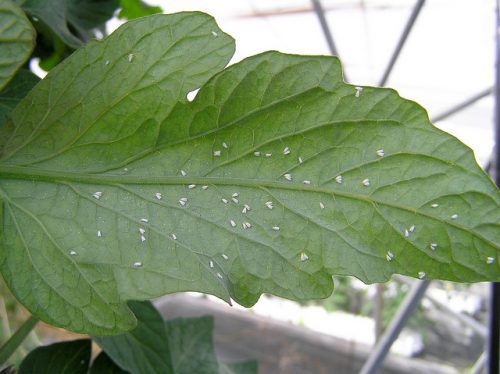
Description of life
The whitefly moth has a white color and lives on the leaves of tomatoes, eating liquid from them and disrupting the metabolism in the plant. This entails spoiling the crop and reducing the volume of tomatoes.
Other signs of whitefly activity are:
- yellow and dried leaves;
- heterogeneous ripening tomato;
- the flesh becomes white.
The active life of whiteflies is carried out on the underside of the leaf, but transparent spots form on the top. Over time, they change color to black. Such a plaque is a fungal disease that provokes the activity of insects.
It is enough to conduct processing of planting material several times with a mixture of soap and special means to eliminate the threat of infection. For effective treatment, it is necessary to use those drugs, which include:
- pyrethrum;
- pyrimifosmethyl.
The insect whitefly carries the virus and provokes leaf and fruit diseases in the plant. Over time, her works provoke a change in the shape and color of leaves, and their death. As a result, the shoots stop growing.
During the treatment of the plant, pay attention to the fact that for the removal of whiteflies you need to use different drugs, depending on the development of the insect.
The moth itself is less dangerous for planting material than its larvae. It is extremely difficult to breed whitefly larvae. They have an outer layer that protects them from external influences, so many drugs are ineffective.
This does not mean that the larvae on seedlings do not need to be hatched; they must be fought with.
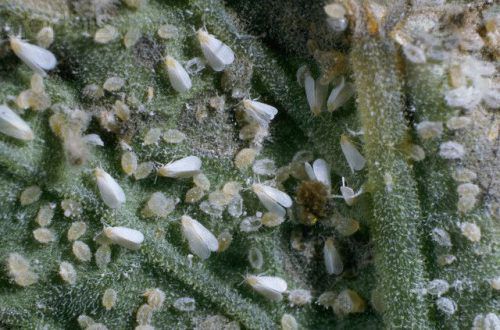
Methods of struggle
The fight against insects should be carried out at any stage of the development of whitefly activity. An effective insect control method can be called:
Fumigation. It should be carried out more than two times a year. For greenhouses located away from home, sulfur candles are suitable as a cigarette lighter. To process them with candles, it is necessary to take out the planting material outside the greenhouse. If the treatment is carried out with conventional preparations, there is no need to take out the tomatoes. Fumigation allows you to destroy an adult and larvae.
There are natural methods for controlling whiteflies. There is a parasite that feeds on this insect and its larvae, with its help eliminate whiteflies.
Chemical treatment of planting material should be carried out in favorable weather. Cloudy weather is better, without rain and wind. You can spend in sunny calm weather and make a shadow form around the planting material.
You can not carry out processing of planting material using a drug that you have already processed tomatoes. The insect whitefly has the ability to develop drug resistance.
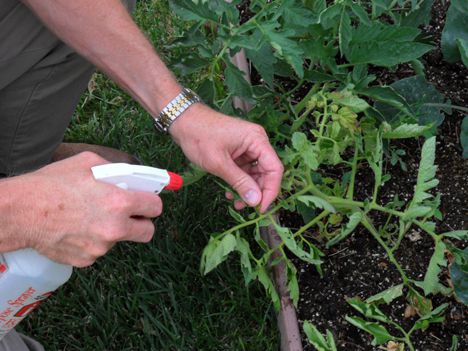
Evil preparations are not used to remove insects from seedlings. If you want to speed up the treatment process, then switching to more saturated drugs is not an option.
The essence of using different drugs:
- Systemic insecticides enter the interior of plants, destroying sucking insects.
- Contact insecticides manifest themselves at the moment of contact with the pest.
- Soap solutions are used to eliminate the pest by a gentle method for the plant.
Based on the yarrow herb, a preparation is prepared that helps in the fight against pest. With the help of a sharp temperature drop or exposure to planting material in gusts of cold air, whiteflies can be eliminated. Pests insects have a negative effect on lowering temperatures.
In the fight against whitefly, adhesive tapes help. Or other means that lubricate sticky drugs.
Water affects moths and is not effective in controlling larvae, even to no avail.
How to get rid of whiteflies
The biggest problems with whiteflies appear in hot and arid weather. Gardeners have to think about how to get rid of these insects. There are several ways to protect plants and future crops from the pest.
Chemical whitefly control
To destroy whiteflies, a huge number of different chemicals are on sale. All drugs presented by well-known manufacturers have instructions on the use of the drug and on contraindications for its use.
As a rule, these funds need to be diluted with water in the right proportions right before use. For a good quick action of the anti-whitefly remedy, the manufacturer's recommendations should be strictly observed.
Depending on the culture and stage of its vegetation, the process of treating a plant against a pest may be different. The most urgent actions against whiteflies should be taken on seedlings, as the consequences can be dire.
The solution should be applied to the entire terrestrial part of the plant. In this case, the concentration of the solution can be increased. Do not worry, because the chemical will decay by the time the ovary is formed.
Whitefly and flowers are no less threatening. Although much smaller than other crops in the garden. If flowers are not planned to be cut for a bouquet, then there are no restrictions on the use of insecticides. In addition, cutting flowers infected with insects for a bouquet, you can infect and domestic plants.
For the treatment of greenhouses against insects, it is better to use alternative means of control.
Alternative Pest Management Methods
The most harmless way of fighting is the mechanical removal of insects from the terrestrial part of the plant. You can shoot down an insect with a stream of water, after which it is imperative to loosen the soil near the stem.
Also, for a greater effect, you can additionally spray the plants with the infusion of garlic. The pungent smell of garlic will make the whitefly look for a more attractive place.
Tomatoes can be protected from whiteflies by treating the leaves of the plant with copper sulfate or a weak solution of lime. This measure will also protect the crop from late blight and premature decay.
Prevention
The appearance of whiteflies in the garden, greenhouses and flower beds is easier to prevent. To do this, in late autumn, you need to dig a plot of land, destroy the tops of plants and weeds.
It is also worth processing all the metal structures of greenhouses.Compost heap should not be placed on the site, because it is a very attractive place for wintering whiteflies and other pests, which can cause you a lot of anxiety next spring.
The appearance of whiteflies on tomatoes in a greenhouse: 3 methods of control
Whitefly on tomatoes in a greenhouse harms the growth and fruiting of plants Growing tomatoes in a greenhouse is a rather complicated process, as it involves a number of mandatory actions and procedures that will help ensure intensive growth and fruiting of plants.
Sometimes it happens that, fulfilling all these requirements, the owners of the greenhouse cannot protect plants from the attack of bacteria, fungi or insect pests. Whitefly on tomatoes in a greenhouse is one of the most dangerous insects that infect tomatoes.
Pest Signs
Whitefly parasitizes on tomatoes, and if you can not get rid of it, it can not only spoil the leaves of the plant, but also lead to the death of all fruits. Small flying white moths sit on the lower parts of the leaves and lay larvae there. Larvae feed on juice and water, which are rich in tomato leaves.
In nature, whitefly is presented in several varieties, but only greenhouse whitefly "loves" tomatoes.
Whiteflies are very dangerous for greenhouse plants. They not only take all juices from them, but also lead to the spread of fungi on plants, which lead to blackening of tomato leaves.
It so happens that moths do not have time to lay off larvae, but only settle on the leaves of plants - this is the most important time to get rid of pests.
Signs of whitefly plant damage:
- Tomato leaves turn yellow and curl.
- The fruits ripen unevenly.
- Inside the fruits are streaks of white.
- When you touch the bush, a cloud of white midges rises into the air.
If only midges without larvae were found on the bushes, immediately treat the bushes with soapy water or insecticides. Solutions from pyrethrum or pyrimiphosmethyl help well. Whitefly is dangerous because it can lead to infection of plants. From this, plants can get jaundice, chlorosis, or curly leaves.
With larvae, at different stages of development, there is a tough struggle, since for each stage of development of insects a drug of a certain type acts.
A special plaque on the larvae can save insects from the effects of a particular drug. The effectiveness of the method is determined by the intensity of plant damage. To prevent the attack of harmful insects, preventive procedures can be carried out.
Types of Insect Control
Fumigation. It should be carried out several times a year. If the greenhouse is located remotely from the living room, fumigation can be carried out using faithful candles. Checkers with insecticides will relieve adult individuals and larvae, while not damaging the plants.
Biological methods. Special insects are placed on bushes so that they destroy the larvae at any stage of their development.
All methods of struggle are effective. Each owner chooses a method of struggle for himself. When working with chemicals, it is very important to observe safety precautions so as not to cause harm to health, plants and fruits.
Chemical methods
When choosing a chemical agent, you need to be extremely careful.It should not harm the plants themselves. It is very important to ensure that chemicals do not scatter beyond the place where the treatment is carried out.
The use of aggressive substances is dangerous, since they not only kill insects, but are also absorbed into the soil, and are removed from there for a very long time. For repeated treatment, the drug must be changed, since insects can develop immunity to the same drug.
Types of drugs:
- Insecticide. It enters the sap of plants, and with it the larvae that feed on it.
- Contact insecticide. Insects die on contact with the drug.
- Soap base. Eliminates a large number of adults.
Whitefly needs to be fought immediately after it has been discovered. It’s easy to deal with large moths, they can be scared away by simply spraying the plants. But the struggle with the larvae can drag on. Since a special plaque protects them from death, not every drug can cope with it.
Fight folk remedies
There are gardeners who eagerly oppose the use of chemicals to control pests. Using chemicals is, of course, effective, but not always necessary. You can fight pests with the help of folk remedies.
Cold is bad for whiteflies. If the tomato variety allows, they can be temporarily taken out of the greenhouse to fresh air.
If there are many whiteflies, you can catch them with glue traps. To do this, glue should be applied to cardboard, preferably bright yellow. Such traps attract moths.
Spray method:
- Wipe the leaves with infusion of millennial.
- Spray the plants with a weak solution based on laundry soap.
- You can use garlic tincture.
- To combat adult moths, you can use plain water.
It is better not to fight insects, but to prevent their appearance. Sometimes the fight against moths takes a very long time and is unsuccessful. It is important not to let the moths breed.
Whitefly Prevention Tips:
- Frequent airing. Moths are thermophilic and cannot tolerate temperatures below fifteen degrees.
- Weed plants in a timely manner and make sure that weeds do not grow next to tomatoes.
- For each new landing, the earth needs to be dug up and processed with special solutions.
- Compost must not be kept in a greenhouse - this is a cozy place for whiteflies to live.
Preventing the appearance of insects in the greenhouse is easier than getting rid of them. It is important to notice the appearance of insects in time. To do this, carefully monitor the condition of the leaves and fruits of plants. The first signs of the appearance of whiteflies: yellowing and fading leaves, as well as the appearance of white moths.
If yellow spots begin to appear on the plants, the leaves of the flock curl up and wither, the fruits ripen not so fast - it means that a whitefly has settled on the leaves of the tomatoes. This is a harmful insect that drinks tomato juice and water, causing plants and their fruits to die.
leave a comment